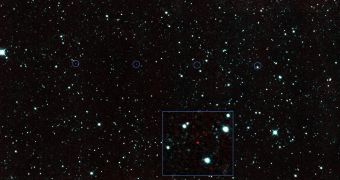After spending more than 31 months in hibernation following its decommissioning in 2011, a NASA asteroid- and comet-hunting telescope has been resurrected in September 2013. Now, astronomers with the mission present their first results, including an image of a brand-new asteroid around our planet.
The NASA Wide-field Infrared Survey Explorer (WISE) spacecraft was put in a hibernation mode in 2011, after its coolant ran out, and it became unable to conduct the infrared sky surveys it was built for.
A couple of years later, NASA experts proposed that the mission be revived under the name Near-Earth Object Wide-field Infrared Survey Explorer (NEOWISE), and used to track asteroid, comets and meteors passing by our planet, or that are on a course towards Earth.
After being reactivated last year, NEOWISE began conducting surveys of the areas immediately around Earth, and was able to detect the NEO asteroid 2013 YP139 on December 29, 2013. The announcement was made recently by experts at the NASA Jet Propulsion Laboratory, in California.
The discovery was confirmed using the Spacewatch telescope at the Kitt Peak National Observatory, in a study led by astronomers at the University of Arizona. Follow-up observations were also conducted using the Great Shefford Observatory, in West Berkshire, England.
“We are delighted to get back to finding and characterizing asteroids and comets, especially those that come into Earth's neighborhood. With our infrared sensors that detect heat, we can learn about their sizes and reflectiveness,” says JPL NEOWISE principal investigator, Amy Mainzer.
According to asteroid data collected thus far, 2013 YP139 now flies around 43 million kilometers (27 million miles) away from Earth, and has a diameter of around 650 meters (0.4 miles). NEOWISE found that the object is dark, coal-like in color, unlike conventional asteroids that have more of a grayish tint.
JPL experts say that the space rock is cataloged as potentially dangerous, since it orbits the Sun in an elliptical orbit outside the plane of the solar system. However, even if the asteroid does hit Earth, it will not impact this century.
During the course of its original mission, the accurate infrared detectors on the spacecraft were able to study a total of 158,000 asteroids in the solar system, in addition to detecting 34,000 new asteroids.
NASA scientists now hope to use NEOWISE to further characterize these objects (a secondary mission objective following the discovery of new, potentially-hazardous space rocks.

 14 DAY TRIAL //
14 DAY TRIAL //